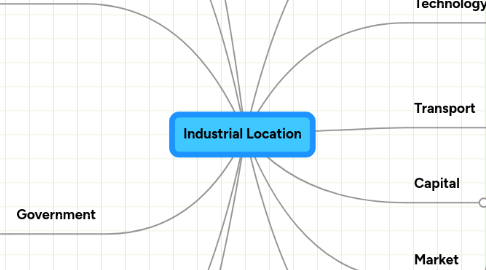
1. Raw Materials
1.1. weight-losing indys
1.1.1. locate close to source of r.m
1.1.1.1. reduce transportation costs
1.1.1.1.1. maximise profits
1.2. perishable r.m
1.2.1. must be near to source
1.2.1.1. ensure freshness of r.m
1.2.1.2. cut down on transportation costs
2. Water
2.1. uses
2.1.1. coolant for machinery
2.1.2. raw material
2.1.3. transportation
2.1.3.1. at ports
2.1.3.1.1. foreign export of products
2.1.4. hydroelectric generation
2.1.5. cleaning agent
2.1.6. biomedical indys
2.1.6.1. clean water is impt
3. Labour
3.1. dependent on nature of indys
3.1.1. labour-intensive
3.1.1.1. abundant and cheap labour
3.1.2. require specialised and highly-skilled labour
3.1.2.1. located
3.1.2.1.1. near universities or education institutions
3.1.2.1.2. in areas with high literacy rate
4. Government
4.1. attract investors
4.1.1. peaceful political climate
4.1.1.1. conducive for setting up business
4.1.2. supportive policies
4.1.2.1. setting up indy estates
4.1.2.2. granting of pioneer status which excempts company from taxation
4.1.2.3. eg. S'pore,South Korea
4.1.2.4. offer financial incentives(eg. tax exemptions and bank loans with low i.r)
4.1.2.4.1. S'pore govt. encouraged TNCs to set up branches in 1970s with attractive incentive packages
4.2. determine location of indys
4.2.1. planning and development of indy estates and specialised parks
4.2.1.1. infrastructure and facilities provided for companies to carry out their activities
4.3. restrict,limit certain indys
4.3.1. prevent uncontrolled growth of indys into residential,recreational areas
4.3.1.1. establish Green Belt zones
4.3.1.1.1. eg. in S'pore,polluting indys locate in certain areas known as 'B2 zones'
4.3.1.2. pass laws
4.4. placed importance on quaternary indys
4.4.1. encourage and enhance value-added indys
4.4.1.1. eg. Biopolis biomedical research hub
5. Agglomeration
5.1. tendency for indys to concentrate in a region
5.1.1. pool of skilled labour build up
5.1.2. factories save on transport costs when it obtains r.m
5.1.3. existing indy linkages
5.1.3.1. basic requirements available(eg. financial services,consultancies)
5.1.4. economies of scale
5.1.4.1. bulk purchases
5.1.5. attract more businesses
6. Industrial Momentum
6.1. tendency of an indy to remain in a region though original facors are no longer impt
6.1.1. immobile plant and machinery
6.1.1.1. selling them off would mean a loss
6.1.2. costly yo invest in new plant
6.1.3. skilled labour,supporting services built up over time
6.1.4. existing indy area may have gained reputation for production of certain goods
7. Land
7.1. Flat
7.1.1. Yes
7.1.1.1. very small overhead cost
7.1.1.1.1. no need flatten land
7.2. Large area
7.2.1. enable easier expansion
7.2.1.1. without incurring much cost
7.2.2. lower cost of land
7.2.2.1. in large supply/abundance
8. Energy
8.1. near energy sources(eg. oil,coal)
8.1.1. indys requiring large supply of energy
8.2. constant supply of energy
8.2.1. no disruption
8.2.1.1. may result in delay in production process
9. Capital
9.1. lower capital required
9.1.1. pre-built factory spaces
9.1.2. low-interests loans
9.1.2.1. financial institutes
9.1.3. govt. grants
10. Market
10.1. weight-gaining indys
10.1.1. set up near markets
10.1.1.1. reduce transport costs
10.2. dependent on customers
10.2.1. sec. indys near markets
10.2.1.1. ensure perishable products in fresh condition
10.2.2. tertiary indys locate near market
10.2.2.1. success depends on ability to sell service
10.2.2.1.1. needs to be convenient,accessible
11. Transport
11.1. good transport system
11.1.1. increased accessibility with diff. nodes of transports
11.1.1.1. source of r.m,indys,and market are linked
11.1.1.1.1. production process not delayed
11.1.2. workers get to work punctually
11.1.2.1. no delay in production
11.1.3. goods delivered faster
11.1.3.1. new markets far away can be tapped
12. Technology
12.1. increasing connectedness between countries(eg. video conferencing, high speed communication lines)
12.1.1. setting up of overseas branches
12.1.2. outsourcing of work to other countries
12.1.2.1. eg. HP services
12.2. quick transmission of info
12.2.1. infrastructure such as mass comm. media and internet access
12.2.1.1. such location preferred by quaternary indys
